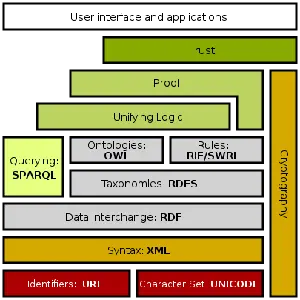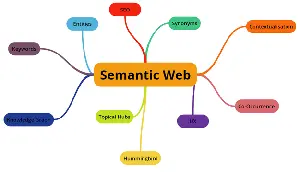About semantic web technologies
Published:
 Semantic web technologies are a set of tools and standards for representing and sharing data on the World Wide Web in a way that allows machines to understand and process the data. The goal of the semantic web is to create a common framework that allows data to be shared and reused across different applications and domains, enabling more intelligent and efficient access to information. The semantic web relies on the use of explicit and standardized definitions of the meanings of data elements, known as “ontologies,” which provide a common vocabulary for describing and organizing data. This allows machines to understand the relationships between different data elements and to process and analyze the data in a more meaningful way.
Semantic web technologies are a set of tools and standards for representing and sharing data on the World Wide Web in a way that allows machines to understand and process the data. The goal of the semantic web is to create a common framework that allows data to be shared and reused across different applications and domains, enabling more intelligent and efficient access to information. The semantic web relies on the use of explicit and standardized definitions of the meanings of data elements, known as “ontologies,” which provide a common vocabulary for describing and organizing data. This allows machines to understand the relationships between different data elements and to process and analyze the data in a more meaningful way.
Semantic web technologies work by representing data in a structured and standardized way, using ontologies to provide a common vocabulary for describing and organizing the data. This structured data can then be published on the web and accessed by machines, which are able to understand and process the data based on its meaning and context. One of the key technologies used in the semantic web is the Resource Description Framework (RDF), which is a standard for representing data in a machine-readable form. RDF data consists of a series of “triples,” which are made up of a subject, predicate, and object, and can be used to represent any type of data, including information about people, events, and relationships. Other technologies used in the semantic web include the Web Ontology Language (OWL) and the SPARQL query language, which are used to define and query ontologies and RDF data.
There are several benefits to using semantic web technologies, including:
Improved access to and integration of data: The semantic web allows data from different sources to be integrated and accessed in a more seamless and efficient way, as machines are able to understand and process the data based on its meaning and context.
Enhanced search and discovery: The use of ontologies and standardized vocabularies allows for more precise and effective search and discovery of information on the web.
Greater interoperability: The semantic web promotes interoperability by providing a common framework for representing and sharing data, which allows data to be more easily reused and combined across different applications and domains.
Increased automation: The ability of machines to understand and process data based on its meaning enables a higher level of automation, leading to greater efficiency and productivity.
New applications and services: The semantic web enables the development of new applications and services that are able to leverage the structured and interoperable data available on the web.
There are several challenges and limitations to the adoption and use of semantic web technologies:
Complexity: The semantic web requires the use of complex technologies and standards, which can be difficult to understand and implement, particularly for non-technical users.
Lack of widespread adoption: Despite the potential benefits of the semantic web, adoption of the technologies has been slow, and many web developers and users are still unfamiliar with them.
Lack of data quality and consistency: The effectiveness of the semantic web depends on the quality and consistency of the data that is represented and shared, which can be a challenge to ensure.
Privacy and security concerns: The sharing of data on the semantic web raises concerns about privacy and security, as the data is more easily accessible and interpretable by machines.
Limited support for complex data: While the semantic web is well-suited for representing simple and structured data, it may not be as effective for representing more complex and unstructured data.
 There are many examples of the use of semantic web technologies in a variety of applications and domains. Some examples include:
There are many examples of the use of semantic web technologies in a variety of applications and domains. Some examples include:
Life sciences: The semantic web has been used in the life sciences to represent and share data about genes, proteins, and other biological entities, enabling more efficient and effective access to and analysis of the data.
Digital libraries: The semantic web has been used to represent and share data about books, articles, and other library resources, allowing for more precise and effective search and discovery of information.
Geospatial data: The semantic web has been used to represent and share geospatial data, such as maps and location-based information, enabling more efficient and effective access and analysis of the data.
e-Commerce: The semantic web has been used to represent and share data about products, services, and customer reviews, allowing for more effective search and discovery of information and more personalized recommendations.
Social media: The semantic web has been used to represent and share data about people, relationships, and events on social media platforms, enabling more intelligent and personalized services.
There are several tools and technologies used for the semantic web, including:
Resource Description Framework (RDF): A standard for representing data in a machine-readable form, used to represent and share data on the semantic web.
Web Ontology Language (OWL): A language for defining and representing ontologies, used to provide a common vocabulary for describing and organizing data on the semantic web.
SPARQL: A query language for accessing and manipulating RDF data, used to query and analyze data on the semantic web.
RDF triple stores: A type of database designed to store and manage RDF data, used to store and manage data on the semantic web.
Semantic web frameworks and libraries: A set of tools and libraries for building and working with semantic web applications, such as Apache Jena and TopBraid.
These tools and technologies are used to create and manage the structured and interoperable data that is shared on the semantic web.